Unit 4 Everyday economics Developing ideas Reading 课件 (共27张PPT)2024-2025学年高二英语外研版(2019)选择性必修4
文档属性
| 名称 | Unit 4 Everyday economics Developing ideas Reading 课件 (共27张PPT)2024-2025学年高二英语外研版(2019)选择性必修4 | 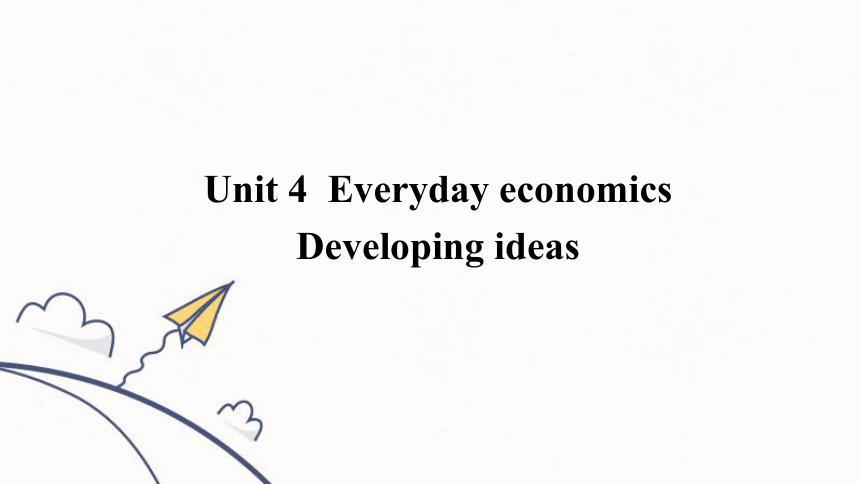 | |
| 格式 | pptx | ||
| 文件大小 | 5.9MB | ||
| 资源类型 | 教案 | ||
| 版本资源 | 外研版(2019) | ||
| 科目 | 英语 | ||
| 更新时间 | 2025-04-23 09:01:10 | ||
图片预览

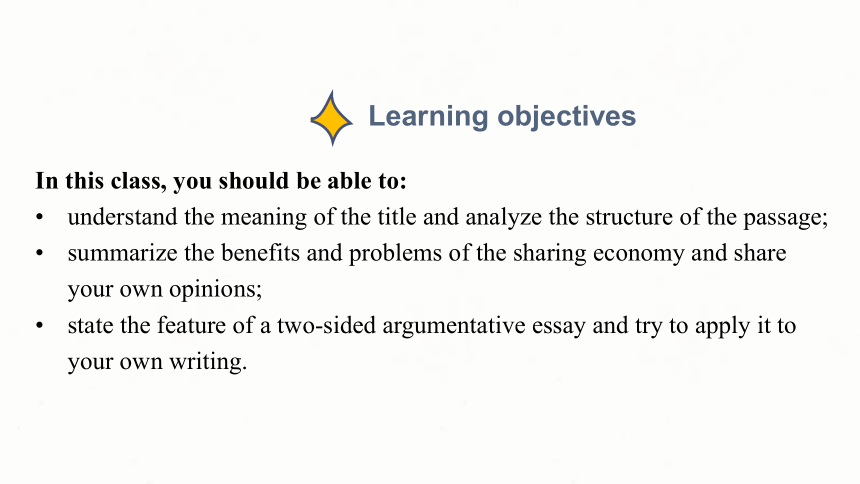
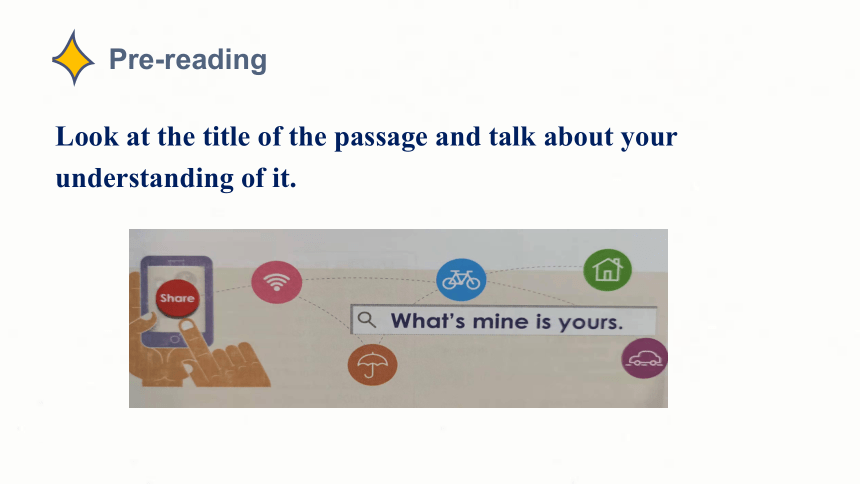


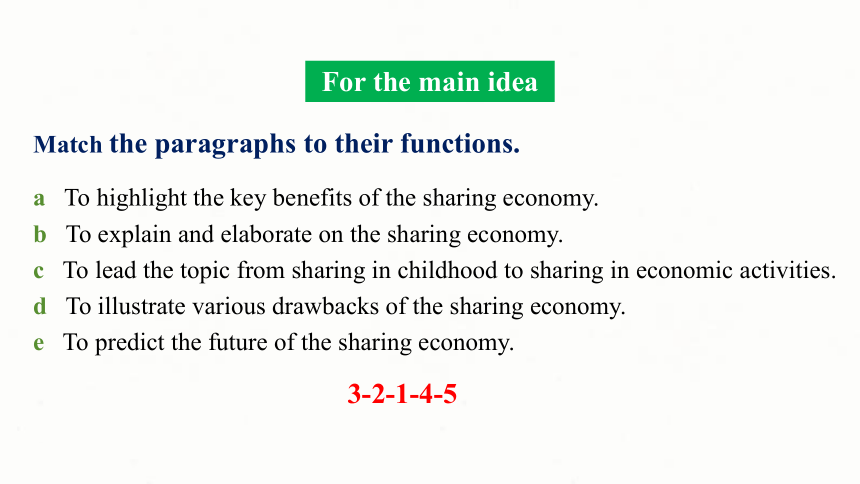

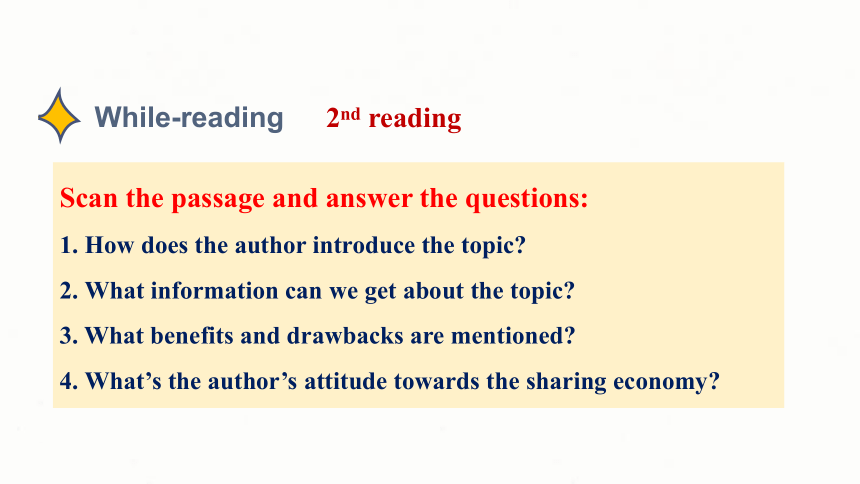

文档简介
(共27张PPT)
Unit 4 Everyday economics
Developing ideas
In this class, you should be able to:
understand the meaning of the title and analyze the structure of the passage;
summarize the benefits and problems of the sharing economy and share your own opinions;
state the feature of a two-sided argumentative essay and try to apply it to your own writing.
Learning objectives
Look at the title of the passage and talk about your understanding of it.
Pre-reading
Tasks:
1. Check your understanding.
2. What is the topic of the passage
3. What’s the relationship between the title and the topic
1st reading
While-reading
the topic:
the sharing
economy
Match the paragraphs to their functions.
3-2-1-4-5
For the main idea
a To highlight the key benefits of the sharing economy.
b To explain and elaborate on the sharing economy.
c To lead the topic from sharing in childhood to sharing in economic activities.
d To illustrate various drawbacks of the sharing economy.
e To predict the future of the sharing economy.
How does the author organize the passage
the topic:
the sharing
economy
para 1
para 2
para 3
para 4
para 5
introduction
conclusion
main body
What is the genre of the passage
argumentation
For the structure
2nd reading
Scan the passage and answer the questions:
1. How does the author introduce the topic
2. What information can we get about the topic
3. What benefits and drawbacks are mentioned
4. What’s the author’s attitude towards the sharing economy
While-reading
1. How does the author introduce the topic
2. What information can we get about the topic
a two-sided argumentative essay
Para 3
Para 4
Critical thinking
A two-sided argumentative essay investigates a topic by presenting collated information and
evaluating evidence from both sides. It should close by wrapping up the argument. It could conclude in favour of the arguments, or simply stay neutral with no particular preference.
Learning to learn
Benefits
3. What benefits and drawbacks are mentioned
Benefits
Benefits
quality goods and services at competitive prices
make connections
make new friends
reducing pollution
encouraging people to reuse items
3. What benefits and drawbacks are mentioned
Drawbacks / Problems
Drawbacks / Problems
Drawbacks / Problems
Drawbacks / Problems
Drawbacks / Problems
Drawbacks / Problems
existing regulations or ongoing supervision
abuse of trust
almost every part of our lives
not yet secure
Drawbacks / Problems
quality goods and services at
competitive prices
make connections
make new friends
encouraging people to reuse items
reducing pollution
existing regulations or
ongoing supervision
abuse of trust
almost every part of our lives
not yet secure
3. What benefits and drawbacks are mentioned
What do you think are other benefits and problems of the sharing economy How could we address the potential problems
Read the report and find some clues.
Critical thinking
4. What’s the author’s attitude towards the sharing economy
The author acknowledges the benefits of the sharing economy, but he also takes concern about the problems of it. The author is also curious about the future of the sharing economy.
Think about what will happen in the next 20 years as the world’s economy becomes ever more global and digital. Consider the following:
What will people be sharing next
How will they be sharing these things
What benefits will people get from sharing these things
What are the potential problems
Post-reading
interview & share
Share your ideas with your group.
Present your group’s ideas to the class.
Now think about how the other groups’ ideas were different to your own and whether you agree with them.
Unit 4 Everyday economics
Developing ideas
In this class, you should be able to:
understand the meaning of the title and analyze the structure of the passage;
summarize the benefits and problems of the sharing economy and share your own opinions;
state the feature of a two-sided argumentative essay and try to apply it to your own writing.
Learning objectives
Look at the title of the passage and talk about your understanding of it.
Pre-reading
Tasks:
1. Check your understanding.
2. What is the topic of the passage
3. What’s the relationship between the title and the topic
1st reading
While-reading
the topic:
the sharing
economy
Match the paragraphs to their functions.
3-2-1-4-5
For the main idea
a To highlight the key benefits of the sharing economy.
b To explain and elaborate on the sharing economy.
c To lead the topic from sharing in childhood to sharing in economic activities.
d To illustrate various drawbacks of the sharing economy.
e To predict the future of the sharing economy.
How does the author organize the passage
the topic:
the sharing
economy
para 1
para 2
para 3
para 4
para 5
introduction
conclusion
main body
What is the genre of the passage
argumentation
For the structure
2nd reading
Scan the passage and answer the questions:
1. How does the author introduce the topic
2. What information can we get about the topic
3. What benefits and drawbacks are mentioned
4. What’s the author’s attitude towards the sharing economy
While-reading
1. How does the author introduce the topic
2. What information can we get about the topic
a two-sided argumentative essay
Para 3
Para 4
Critical thinking
A two-sided argumentative essay investigates a topic by presenting collated information and
evaluating evidence from both sides. It should close by wrapping up the argument. It could conclude in favour of the arguments, or simply stay neutral with no particular preference.
Learning to learn
Benefits
3. What benefits and drawbacks are mentioned
Benefits
Benefits
quality goods and services at competitive prices
make connections
make new friends
reducing pollution
encouraging people to reuse items
3. What benefits and drawbacks are mentioned
Drawbacks / Problems
Drawbacks / Problems
Drawbacks / Problems
Drawbacks / Problems
Drawbacks / Problems
Drawbacks / Problems
existing regulations or ongoing supervision
abuse of trust
almost every part of our lives
not yet secure
Drawbacks / Problems
quality goods and services at
competitive prices
make connections
make new friends
encouraging people to reuse items
reducing pollution
existing regulations or
ongoing supervision
abuse of trust
almost every part of our lives
not yet secure
3. What benefits and drawbacks are mentioned
What do you think are other benefits and problems of the sharing economy How could we address the potential problems
Read the report and find some clues.
Critical thinking
4. What’s the author’s attitude towards the sharing economy
The author acknowledges the benefits of the sharing economy, but he also takes concern about the problems of it. The author is also curious about the future of the sharing economy.
Think about what will happen in the next 20 years as the world’s economy becomes ever more global and digital. Consider the following:
What will people be sharing next
How will they be sharing these things
What benefits will people get from sharing these things
What are the potential problems
Post-reading
interview & share
Share your ideas with your group.
Present your group’s ideas to the class.
Now think about how the other groups’ ideas were different to your own and whether you agree with them.
